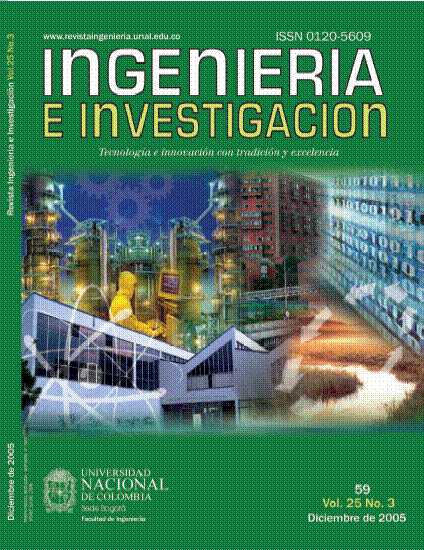Applying optimization techniques for validating a numeric model of free aquifers
Aplicación de técnicas de optimización para la validación de un modelo numérico de acuíferos inconfinados
DOI:
https://doi.org/10.15446/ing.investig.v25n3.14656Keywords:
optimisation, spline, design variable, state variable, objective function (en)optimización, variables de diseño, variables de estado, función objetivo (es)
Downloads
The present work presents an alternative for determining free surface in free aquifers using the optimization techniques available in ANSYS (commercial finite elements' software). This is able to handle variable meshes through optimization algorithm iterations. This represents an advantage in terms of precision re methods using a constant mesh. Design variables were parametrically defined by means of vertical coordinates, or key point levels, which were interconnected by means of splines for estimating the free surface. State variables were the values of temperature at key points which were analogous at the top of the water by thermal analogy. The objective function is the absolute value of the difference between the vertical coordinates or levels and the calculated values of temperature at key points. These techniques may be used for determining the position of the water table re free aquifers, resolving the problem of free surface in loose material reservoirs and other types of problems such as fluid mechanics (e.g. flow in canals or swell). Even though these are problems which are very different to those of a porous medium, resolving them is highly non-lineal and requires robust techniques for approaching the phenomena’s real behavior.
Con el presente trabajo se desarrolla una alternativa para determinar el nivel de abatimiento de agua en acuíferos inconfinados, empleando las técnicas de optimización que están disponibles en el programa comercial de elementos finitos ANSYS. Las variables de diseño se definen paramétricamente por medio de las coordenadas verticales o cotas de unos puntos clave, que se interconectan por medio de splines para aproximar la superficie libre. Las variables de estado son los valores de temperatura en los puntos clave, que por analogía térmica son análogos a la cabeza de fluido. La función objetivo es el valor absoluto de la diferencia entre las coordenadas verticales y los valores de temperatura calculados en los puntos clave. Con la verificación de estas técnicas en la determinación de la posición de la tabla de agua en el problema de acuíferos libres, se esté dando solución al problema de la superficie libre en presas de materiales sueltos y por qué no, a otro tipo de problemas, como los de mecánica de fluidos (por ejemplo, el de flujo en canales o el de oleaje), que aunque son problemas bien diferentes al de medio poroso, la solución sí que es altamente no lineal, y se requiere de técnicas robustas para aproximarse suficientemente al comportamiento real del fenómeno.
References
ANSYS user manual
Desai, Chandrakant. y Christian, Jhon T., "Numerical Methods in Geotechnical Engineering", Edit. Mc GrawHill Book Company, USA,1997, pp. 1 - 65, 458 - 506.
Lambe, T. William y Whitman, Robert V., "Mecánica de suelos", Edit. Limusa - Wiley, México, 1963, pp. 225 - 441.
Ledesma, A. "Problemas geotécnicos, apuntes", Centro Internacional de Métodos Numéricos, Barcelona 2003.
Olivella, S.; Carrera, J. "Hidrología subterránea, apuntes", Centro Internacional de Métodos Numéricos, Barcelona, 2003.
Rao, S. S., "The Finite Element Method in Engineering", Edit. Pergamon Press. New York, 1989, pp. 432 - 518, 521 - 592.
Reddy, J. N., "An introduction to the finite element method", McGraw-Hill Book Company, 1984, p. 103.
Rodríguez, W. y Pallares, M., "Determinación de la superficie libre en presas de tierra mediante técnicas de optimización", Revista Ternura, 2004, pp. 33 - 44.
Streeter, Victor L. y Wyllie, Benjamin E., "Mecánica de los Fluidos", Edit. Mc Graw-Hill, México, 1988, pp. 84 162, 323 - 340.
Willey, John & Sons, "Finite Elements in Geomechanics", Interscience Publication, New York, 1979, pp. 496 - 537.
Zienkiewwicz, O. C. y Taylor, R. L., "El método de los elementos finitos", Edit. Mc. Graw-Hill, Barcelona, 1994, pp. 1 - 44, 271 - 298.
How to Cite
APA
ACM
ACS
ABNT
Chicago
Harvard
IEEE
MLA
Turabian
Vancouver
Download Citation
License
Copyright (c) 2005 Wilson Rodríguez Calderón, Myriam Rocío Pallares Muñoz

This work is licensed under a Creative Commons Attribution 4.0 International License.
The authors or holders of the copyright for each article hereby confer exclusive, limited and free authorization on the Universidad Nacional de Colombia's journal Ingeniería e Investigación concerning the aforementioned article which, once it has been evaluated and approved, will be submitted for publication, in line with the following items:
1. The version which has been corrected according to the evaluators' suggestions will be remitted and it will be made clear whether the aforementioned article is an unedited document regarding which the rights to be authorized are held and total responsibility will be assumed by the authors for the content of the work being submitted to Ingeniería e Investigación, the Universidad Nacional de Colombia and third-parties;
2. The authorization conferred on the journal will come into force from the date on which it is included in the respective volume and issue of Ingeniería e Investigación in the Open Journal Systems and on the journal's main page (https://revistas.unal.edu.co/index.php/ingeinv), as well as in different databases and indices in which the publication is indexed;
3. The authors authorize the Universidad Nacional de Colombia's journal Ingeniería e Investigación to publish the document in whatever required format (printed, digital, electronic or whatsoever known or yet to be discovered form) and authorize Ingeniería e Investigación to include the work in any indices and/or search engines deemed necessary for promoting its diffusion;
4. The authors accept that such authorization is given free of charge and they, therefore, waive any right to receive remuneration from the publication, distribution, public communication and any use whatsoever referred to in the terms of this authorization.



























